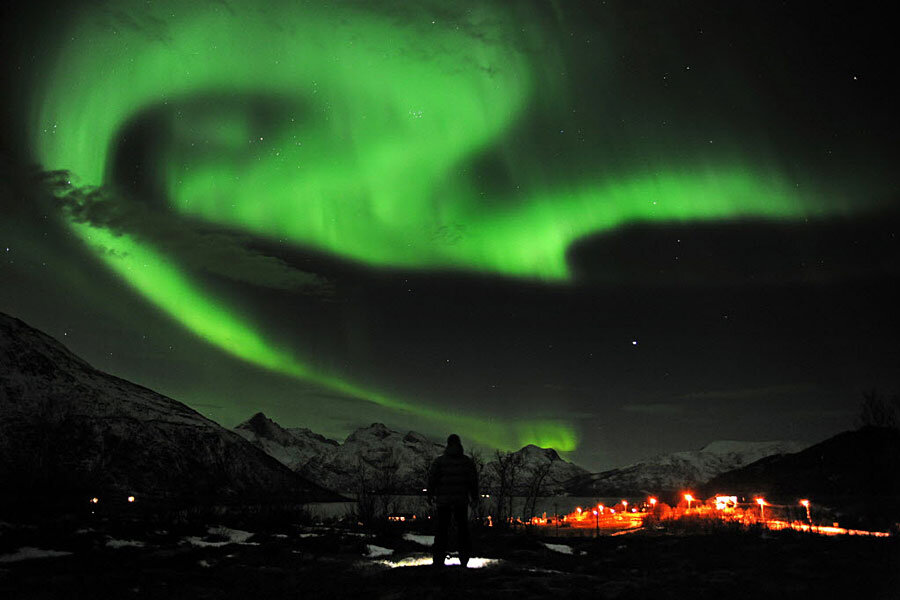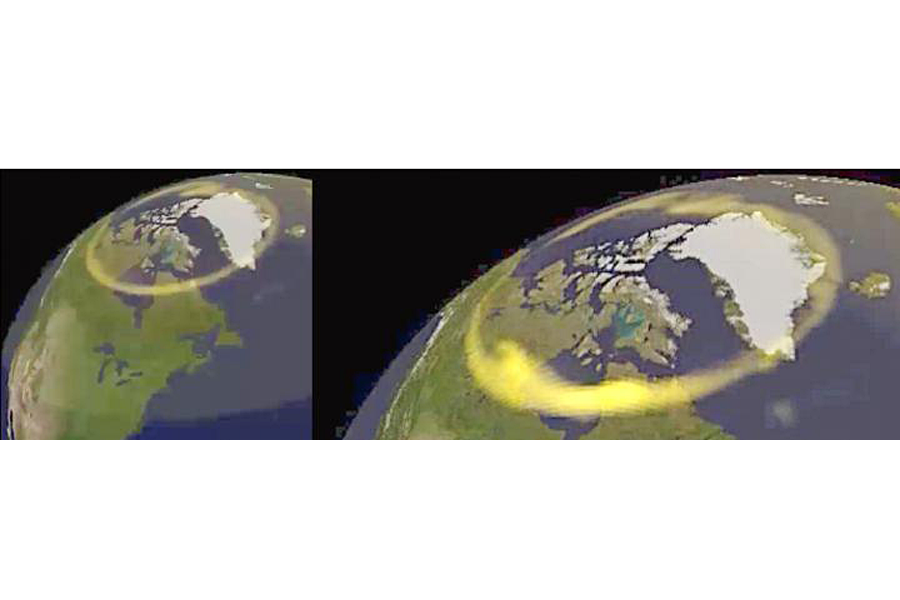Why does an aurora have bursts of brightness?
Loading...
The night sky glows green, with wispy stripes stretching across the dark expanse. Then, the light grows brighter, exploding in color.
Just half an hour later, the spectacle dims again, returning to the feathery glow.
Scientists have puzzled over what causes this phenomenon, called auroral breakup. Although they have generally thought they knew how it all worked, a new paper aims to tie down an explanation using computer simulations.
The bright brief spectacle happens in an electrical interaction between charged particles streaming from the sun and the magnetic field enveloping the Earth, forcing a surge of activity during an aurora. The mechanisms behind auroral breakup are described in the new paper published Monday in the Journal of Geophysical Research.
Auroral breakup is "so beautiful and impressive," study author Yusuke Ebihara of Kyoto University tells The Christian Science Monitor in an interview.
You might catch this spectacular light show if you're not too far from either the North or South pole during their winters. At night during that season, it is normal to see a sort of curtain of light in the sky stretching from East to West. That curtain is the standard aurora, often called Northern or Southern Lights, depending on the region.
The aurora doesn't move much as you watch it. But that could all change if auroral breakup occurs. "The aurora suddenly becomes so bright, starts to dance and starts to expand," Dr. Ebihara describes. "If you are lucky, the bright aurora covers all the sky," he says.
Because it only lasts from around 30 minutes to an hour, you might be able to catch a few of these light surges in a single night.
So how does an aurora work?
"Aurora is a result of an interaction with solar wind, magnetosphere, and atmosphere," Ebihara says.
Plasma – gas that has been heated to the point that it loses or gains electrons, giving it an electrical charge – gets flung from the Sun in what is called solar wind. When the solar winds reach the Earth, the plasma produces electrical currents, which flow around the globe along the Earth's magnetic field.
The electrons forming the field-aligned current follow the Earth's magnetosphere down toward the poles, exciting any molecules and atoms that they collide with in the upper atmosphere. The energy produced by these collisions released from the atom in the form of light. And because different atoms have different energy levels, that light comes in a variety of colors.
But that just describes the baseline of the polar light shows. What causes the spectacular explosions of light seen in auroral breakups?
When the plasma from the sun reaches our planet, it first encounters Earth's magnetic field. That plasma then gets stored in the magnetic field, stretching the field lines out from the Earth on the side away from the Sun, much like an elastic band. But, just like an elastic band snaps when stretched too far, the energy stored in those field lines eventually becomes too much.
When that tension is released, the plasma is hurtled toward the Earth. But the Earth's magnetic field repels it, forcing it, according to this new research, along the magnetic field lines toward the poles. That bulge forces a surge of electrical activity, producing the spectacular auroral breakup.
Seen from Earth, the aurora has been relatively tame up until this point. But just minutes after the field lines reconnect, as scientists call the release of tension in the Earth's magnetic field lines, the display becomes much brighter.
But the details about how the metaphorical elastic band snaps and what happens immediately after were fuzzy for decades.
Because the event occurs way out in the Earth's magnetosphere, it's difficult for scientists to obtain data about what happens. Observations of the real event could take as many as a thousand spacecraft to record, a costly venture. So the research team turned to computer modeling, creating a simulation of an auroral breakup.
The event that causes the bright auroral breakup seen on Earth occurs in just a few minutes, explains Jeffrey Hughes, an astronomer at Boston University, who is not affiliated with the study, in an interview with the Monitor.
Although the question of how auroral breakup occurs "has been bugging us for three or four decades," says Dr. Hughes, he doesn't think this new paper is revolutionary. "They're not saying anything controversial," Hughes says. "They're the sort of ideas we have, but they're basically confirming in their model that's what's going on."
"This looks like a very reasonable paper," Hughes says. He expects to see other researchers compare their own computer models to those detailed in this paper, but "I don't think there'll be any major outcry," he says.
As for why researchers have spent a lot of energy on this question, "It's annoying not understanding something," Hughes says, "It's not going to solve any of the problems of mankind." He says, "It's just better understanding how nature works."









